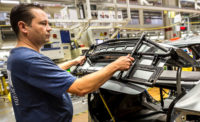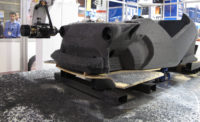Planning for the future is necessary for every manufacturer. Sometimes it involves making plans for the next year or two, or maybe the next five or 10. But, looking 20 years into the future? That’s reserved for select companies, like luxury-car manufacturer Bentley Motors Ltd.
In 2016, Stefan Sielaff, design director at Bentley, discussed its “The Future of Luxury” project, which showcased a concept of what the automaker’s 2036 model might look like. This vehicle is completely autonomous and has no steering wheel.
Instead, the interior is a sort of lounge with two sofas separated by a coffee table and lined with wood and leather. The vehicle also features many 3D-printed components, such as the car’s door hinges, grill and moving parts that facilitate or inhibit the passage of air for cooling or drag reduction.
3D printing parts for its vehicles is not a new practice for Bentley, but a continuation of what the company has done since 2013 at its design studio in Crewe, England. There, several engineers use two 3D printers from Stratasys Ltd. to easily and quickly simulate exactly how different parts will look and function prior to actual production. The two printers are the Objet30 Pro desktop and the Objet500 Connex 3 machine that handles multiple materials.
“The accuracy of the Objet30 enables us to take a full-size part and scale it down to produce a one-tenth scale model,” explains David Hayward, operations and projects manager at the Bentley Design Studio. “Once we have approval at this scale, we can move onto our larger Objet500 to produce one-third scale models, full-sized parts and parts that combine different material properties.”
Hayward says the printers’ high-precision capabilities allow any interior or exterior part to be fabricated and prototyped in miniature—from headlamps, grilles and door mirrors, to moldings, emblems and shifters. Parts are printed in plastic (ranging from clear material to ABS) or rubber.
The Objet500 printer combines different material properties in a single 3D print to produce items as different as a full-size tail pipe trim or a rubber tire on a wheel rim. Its large tray (500 by 400 by 200 millimeters) is ideal for applications requiring large parts, mixed trays or large throughput. More than 100 material options are available, including rigid opaque, transparent, rubber-like, digital and specialty biocompatible materials. The latter are preferred for custom medical devices and research aids.
All three models in the Objet500 series (Connex 1, 2 and 3) feature PolyJet triple-jetting technology, which enables precise printing of complex parts with three materials simultaneously. The technology also allows Bentley designers to simulate rubber with different levels of hardness, elongation and tear resistance in order to produce parts with various tensile strengths. “We’ve even developed designs for actual glassware and the decanter using the clear material,” adds Hayward.
The Objet30 Pro combines the accuracy and versatility of a high-end rapid prototyping machine, with a small footprint. It 3D prints parts in 28-micron-thick layers and handles rigid-opaque, transparent, high-temperature and polypropylene-like materials. Its large tray size (300 by 200 by 150 millimeters) enables users to quickly produce a wide range of parts or products, including small moving parts, consumer goods and electronics, and medical devices.
“Stratasys’ rapid prototyping systems allow us to develop things in a totally new way,” concludes Kevin Baker, design model manager at Bentley’s design studio. “With this technology, we can exactly simulate how the car will look.”
For more information on 3D printers, call 800-801-6491 or visit www.stratasy.com.





